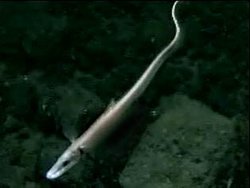Halosaur
|
|
| Halosaurs | ||||||||||
|---|---|---|---|---|---|---|---|---|---|---|
 | ||||||||||
| Scientific classification | ||||||||||
| ||||||||||
| Genera | ||||||||||
Halosaurs are eel-like fish found only at great ocean depths. As the family Halosauridae, halosaurs are one of two families within the order Notacanthiformes; the other being the deep-sea spiny eels. Halosaurs are thought to have a worldwide distribution, with some 17 species in 3 genera represented. Only a handful of specimens have been observed alive, all via chance encounters with ROVs.
From the Greek hals meaning "sea" and sauros meaning "lizard", halosaurs look like living fossils from some throwback era. Their greatly elongated bodies end in a whip-like tail; their scales are large. There is one small dorsal fin close to the sharply pointed, mostly scaleless head. The tail fin is greatly reduced, with the anal fin being the largest fin. Their pecotral fins are slender and also greatly elongated. The mouth is somewhat large, with the lower jaw shorter than the upper jaw. The gas bladder is absent.
The largest species, the 90 centimetre long abyssal halosaur (Halosauropsis macrochir) is also one of the most deep-living fish, recorded at depths of 3,300 metres. Halosaurs have developed certain adaptations to life at these extreme depths, where no light penetrates. Their lateral line system is highly developed; this is a system of pores running the length of the fish's body, lending it a sort of "sixth sense" by detecting nearby vibrations. Some species are also known to hold their elongate pectorals erect and forward, possibly providing a further means of detection.
Halosaurs are benthic fish, spending their time cruising over or resting on the sea floor where temperatures may be just 2-4 degrees Celsius. They propel themselves with rhythmic undulations of the body, not unlike snakes. Halosaurs are thought to prey mainly on benthic invertebrates, such as polychaete worms, echinoderms and crustaceans such as copepods.
In life, most halosaurs are a grey to bluish black in colour. Like other notacanthiform fish, halosaurs are able to regenerate their tails easily if lost. This adaptation can be likened to certain terrestrial reptiles such as the glass lizard, which sacrifices its tail in order to evade predators.
See also
External links
- Video footage of a halosaur from NOAA's Ocean Explorer (http://oceanexplorer.noaa.gov/explorations/02davidson/logs/may21/media/eels_video.html)
- FishBase entry on Halosauridae (http://www.fishbase.org/Summary/FamilySummary.cfm?ID=71)
